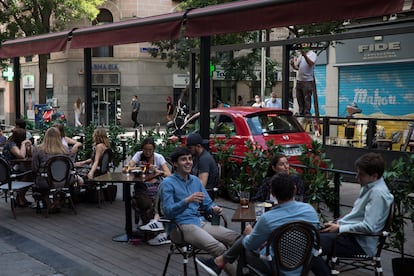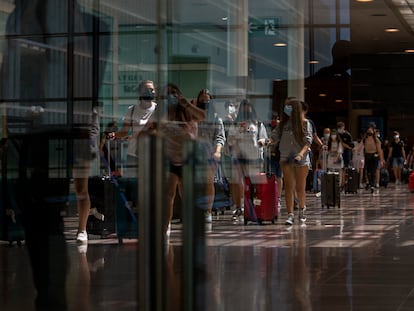Spanish Health Ministry admits that latest traffic light system for coronavirus restrictions are not obligatory for the regions
Although regional and central authorities initially insisted the measures included in the scheme were ‘mandatory,’ the text states that they can be modified according to each territory’s epidemiological situation

Spain’s new traffic light system for coronavirus restrictions can be “adapted and contextualized” by the regions. That’s according to the order published Friday in the Official State Bulletin (BOE).
This is despite the fact that the Inter-Territorial Council of the National Health System (CISNS), which brings together central and regional officials, said that it was “mandatory” for the regions to follow the rules when it approved the new system on Wednesday. This point was reiterated by Health Ministry Carolina Darias that same day and later confirmed by a spokesperson from her department to EL PAÍS.
The traffic light system determines coronavirus restrictions based on the epidemiological situation in an area. Risk is categorized as extreme, high, medium, low and new normality based on data points such as the seven-day and 14-day incidence rate, and the percentage of hospital and intensive care unit (ICU) beds occupied by Covid-19 patients. Under this set of common criteria – to be applied until 70% of the population and all over-50s are vaccinated against Covid-19 – nighttime venues must close by 3am and only 10 people are allowed per bar or restaurant table in outdoor areas in even a low-risk scenario.
Although the measures included in the document “Coordinated response actions to control the transmission of Covid-19” were approved by a majority of Spain’s regions – which are in charge of containing the pandemic in their territories – they were rejected by Catalonia, Madrid, Andalusia, Galicia, Murcia and the Basque Country. These regions are home to 29.5 million people, more than half the country’s population of 47.5 million.
Madrid, which has been at loggerheads with the central government over the reach of coronavirus restrictions since the health crisis began, announced that it would not adhere to the system on the grounds that it would hurt businesses and was encroaching upon the regional government’s powers. The new criteria place the region in the medium-risk category, meaning the number of people allowed on outdoor tables would have to be cut from eight to six and capacity at large events reduced from 7,000 to 2,500.
The Madrid government filed a motion at Spain’s High Court, the Audiencia Nacional, to suspend these restrictions as a precautionary measure – a request it was granted on Monday. But the Health Ministry argued that the court’s decision made little difference, given that the BOE states that the coronavirus measures “can be adapted and contextualized in each region and territory, according to the epidemiological situation.” Indeed, some of Spain’s regions had been doing just this before the CISNS made the recommendations legally binding and not just guidelines.

The provision for regions to “adapt and contextualize” the rules means that they do not have to follow the restrictions to the letter, the Health Ministry explained. It is, however, mandatory for the regions to apply minimum restrictions on the hospitality industry. This means that until 70% of the population is vaccinated – a goal that is expected to be reached on August 18 – capacity in indoor dining areas must remain at 50% (or 60% if there are measures to control transmission such as strong ventilation and air control) and no more than six people are allowed to a table in indoor areas and 10 people outdoors, among other restrictions. So far, all of Spain’s regions are classified between level 1 to 3 on the alert system.
According to the order in the BOE, nighttime venues can be reopened if a region has reached the stage of new normality, at alert level 1, or on level 2, but with the epidemiological curve on a downward trend. In all of these cases, however, capacity cannot exceed 50% and establishments must close at 3am.
Spain’s Basque Country and La Rioja are the only regions classified as high risk (level 3), meaning nighttime venues remain closed. In Andalusia, where the alert ranges from 1 to 4 depending on the area, these establishments are allowed to open until 2am, even though contagion rates are on the rise. Bar consumption at nightclubs is also allowed in the region, even though it is prohibited by the new order. Most of Spain’s regions, however, are following the rules, with nighttime venues closed in most areas.
According to a spokesperson from the Health Ministry, the government has no plans to challenge regions in the courts over their application of the traffic light system, which it believes gives regional authorities enough flexibility to adapt the rules as they see fit. Indeed the ministry called the regions on Monday to discuss changes to the restrictions in the hopes of reaching a broader consensus ahead of the next CISNS meeting on Wednesday.
With reporting by Eva Saiz, Mikel Ormazabal, Juan Navarro, Isabel Valdés and Silvia R. Pontevedra.
English version by Melissa Kitson.
Tu suscripción se está usando en otro dispositivo
¿Quieres añadir otro usuario a tu suscripción?
Si continúas leyendo en este dispositivo, no se podrá leer en el otro.
FlechaTu suscripción se está usando en otro dispositivo y solo puedes acceder a EL PAÍS desde un dispositivo a la vez.
Si quieres compartir tu cuenta, cambia tu suscripción a la modalidad Premium, así podrás añadir otro usuario. Cada uno accederá con su propia cuenta de email, lo que os permitirá personalizar vuestra experiencia en EL PAÍS.
¿Tienes una suscripción de empresa? Accede aquí para contratar más cuentas.
En el caso de no saber quién está usando tu cuenta, te recomendamos cambiar tu contraseña aquí.
Si decides continuar compartiendo tu cuenta, este mensaje se mostrará en tu dispositivo y en el de la otra persona que está usando tu cuenta de forma indefinida, afectando a tu experiencia de lectura. Puedes consultar aquí los términos y condiciones de la suscripción digital.
More information
Últimas noticias
Most viewed
- Sinaloa Cartel war is taking its toll on Los Chapitos
- Oona Chaplin: ‘I told James Cameron that I was living in a treehouse and starting a permaculture project with a friend’
- Reinhard Genzel, Nobel laureate in physics: ‘One-minute videos will never give you the truth’
- Why the price of coffee has skyrocketed: from Brazilian plantations to specialty coffee houses
- Silver prices are going crazy: This is what’s fueling the rally











































